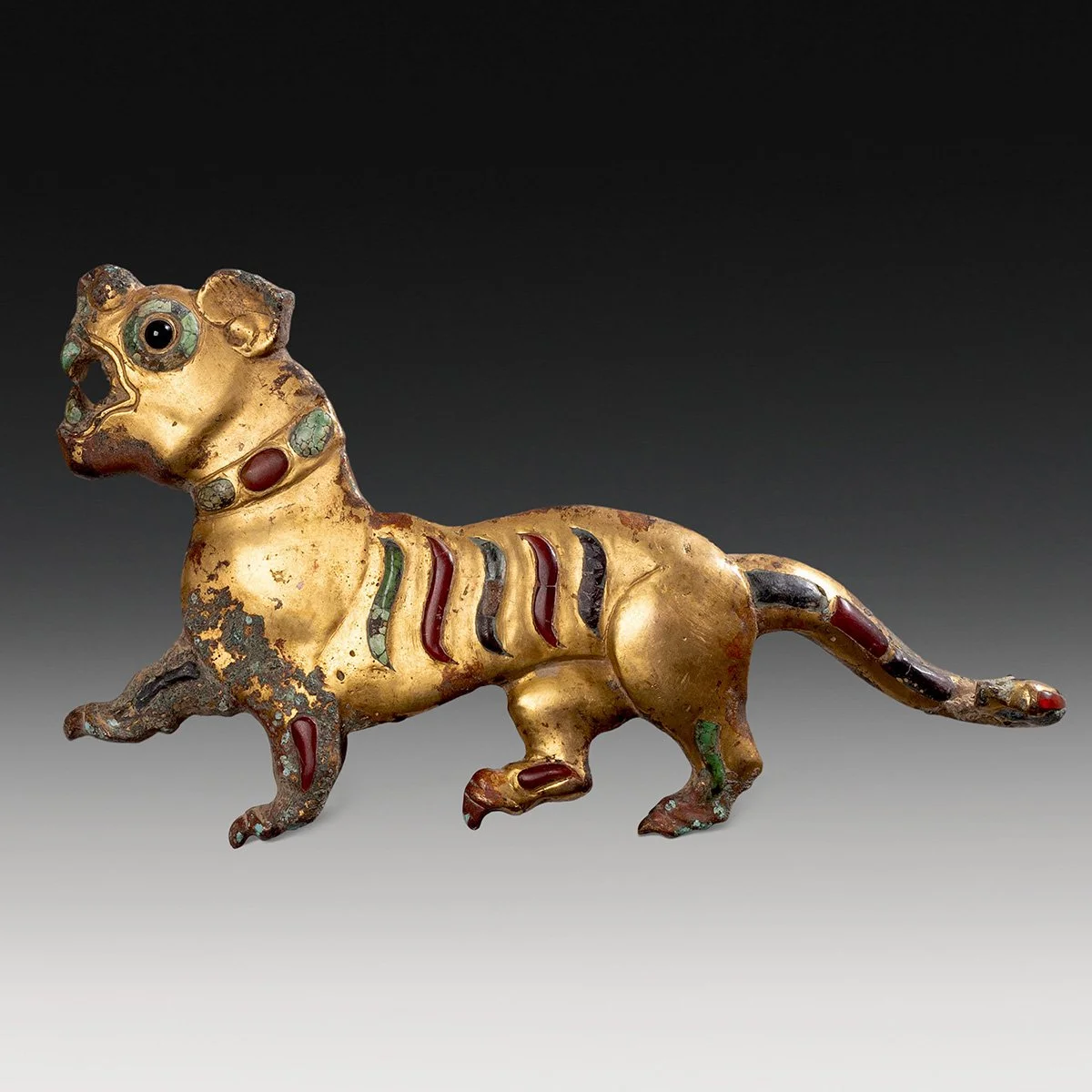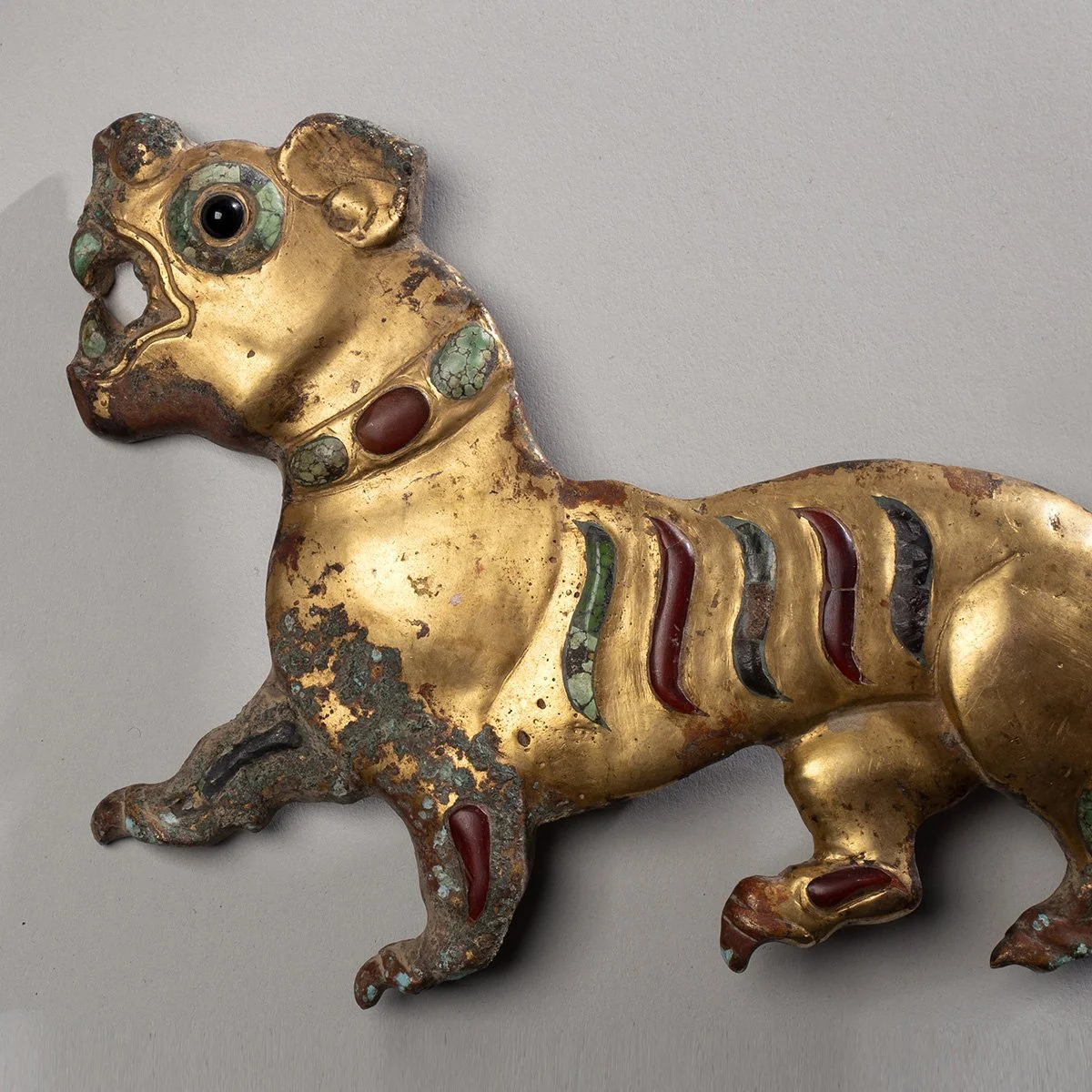 Image 1 of 5
Image 1 of 5

 Image 2 of 5
Image 2 of 5

 Image 3 of 5
Image 3 of 5

 Image 4 of 5
Image 4 of 5

 Image 5 of 5
Image 5 of 5






Superb Gilt Bronze Tiger Garment Hook - Daigou
China
Warring States Period 475-221 BC
Gilt bronze, turquoise, carnelian, obsidian
Length 9.25 inches (23.5 cm)
Provenance: Jean Devenne, London - Ken Mackay, London
Art Loss Register certificate provided: #S00252196
Garment hooks, or daigou, came into elite use during the Warring States period (475 – 221 BC) upon Chinese contact with the Central Asian nomadic populations of the Eastern Eurasian Steppes. Auspicious depictions of animals, including dragons and tigers, proliferated throughout the material culture of the region, and the fluid zoomorphic forms of these splendid garment hooks provided an elegant solution to a practical problem. For warriors and gentlemen, garment hooks were necessary in securing pants and robes against vibration and movement while on horseback. For the royal elite, the opulent garment hooks secured luxurious embroidered silk robes and served as an important means of asserting social prominence; often accompanying the well-dressed to the grave, along with servant and horse, to help the noble establish his status in the underworld.
The garment hook presented here is a masterful example, cast in gilt bronze as a tiger striding on clawed feet with tail extended, its mouth agape, revealing fearsome teeth. The artist sought to express the ferocious aspect and vitality of the tiger, displaying its powerful head and body in elegant profile. The sculpture’s prominent features are further highlighted with inlays of turquoise, red carnelian, and obsidian, their rounded forms emerging organically from the gilt surface. The tiger’s muscular body is also adorned with these precious stones, thoughtfully fashioned and inlaid in a series of distinctive curvilinear stripes. Treasured by a high-ranking warrior or nobleman some two millennia ago, this splendid garment hook captures the tiger’s spirit in vivid distillation, a salient feature of the art created by the nomadic peoples who roamed the steppes of Eastern Eurasia.
China
Warring States Period 475-221 BC
Gilt bronze, turquoise, carnelian, obsidian
Length 9.25 inches (23.5 cm)
Provenance: Jean Devenne, London - Ken Mackay, London
Art Loss Register certificate provided: #S00252196
Garment hooks, or daigou, came into elite use during the Warring States period (475 – 221 BC) upon Chinese contact with the Central Asian nomadic populations of the Eastern Eurasian Steppes. Auspicious depictions of animals, including dragons and tigers, proliferated throughout the material culture of the region, and the fluid zoomorphic forms of these splendid garment hooks provided an elegant solution to a practical problem. For warriors and gentlemen, garment hooks were necessary in securing pants and robes against vibration and movement while on horseback. For the royal elite, the opulent garment hooks secured luxurious embroidered silk robes and served as an important means of asserting social prominence; often accompanying the well-dressed to the grave, along with servant and horse, to help the noble establish his status in the underworld.
The garment hook presented here is a masterful example, cast in gilt bronze as a tiger striding on clawed feet with tail extended, its mouth agape, revealing fearsome teeth. The artist sought to express the ferocious aspect and vitality of the tiger, displaying its powerful head and body in elegant profile. The sculpture’s prominent features are further highlighted with inlays of turquoise, red carnelian, and obsidian, their rounded forms emerging organically from the gilt surface. The tiger’s muscular body is also adorned with these precious stones, thoughtfully fashioned and inlaid in a series of distinctive curvilinear stripes. Treasured by a high-ranking warrior or nobleman some two millennia ago, this splendid garment hook captures the tiger’s spirit in vivid distillation, a salient feature of the art created by the nomadic peoples who roamed the steppes of Eastern Eurasia.
China
Warring States Period 475-221 BC
Gilt bronze, turquoise, carnelian, obsidian
Length 9.25 inches (23.5 cm)
Provenance: Jean Devenne, London - Ken Mackay, London
Art Loss Register certificate provided: #S00252196
Garment hooks, or daigou, came into elite use during the Warring States period (475 – 221 BC) upon Chinese contact with the Central Asian nomadic populations of the Eastern Eurasian Steppes. Auspicious depictions of animals, including dragons and tigers, proliferated throughout the material culture of the region, and the fluid zoomorphic forms of these splendid garment hooks provided an elegant solution to a practical problem. For warriors and gentlemen, garment hooks were necessary in securing pants and robes against vibration and movement while on horseback. For the royal elite, the opulent garment hooks secured luxurious embroidered silk robes and served as an important means of asserting social prominence; often accompanying the well-dressed to the grave, along with servant and horse, to help the noble establish his status in the underworld.
The garment hook presented here is a masterful example, cast in gilt bronze as a tiger striding on clawed feet with tail extended, its mouth agape, revealing fearsome teeth. The artist sought to express the ferocious aspect and vitality of the tiger, displaying its powerful head and body in elegant profile. The sculpture’s prominent features are further highlighted with inlays of turquoise, red carnelian, and obsidian, their rounded forms emerging organically from the gilt surface. The tiger’s muscular body is also adorned with these precious stones, thoughtfully fashioned and inlaid in a series of distinctive curvilinear stripes. Treasured by a high-ranking warrior or nobleman some two millennia ago, this splendid garment hook captures the tiger’s spirit in vivid distillation, a salient feature of the art created by the nomadic peoples who roamed the steppes of Eastern Eurasia.

